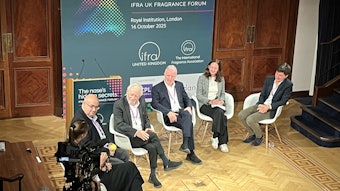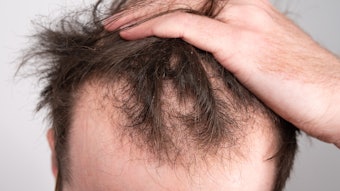Nanometer-scale components such as nanoparticles are increasingly common in modern cosmetic formulations, and they accomplish (or at least purport to accomplish) a variety of different functions and effects, including improved sunscreening, unique color effects, and even strengthened mechanical and chemical bonding. With such increasing use of nanometer-scale components—that is, particles or structures in the range of 1–100 nm in size—there has also been a corresponding increase in the number of patent applications and patents issued in the field by the US Patent and Trademark Office (PTO). The challenge for an inventor and his or her legal counsel, however, relates to how to describe and claim these nanometer-scale features of the invention in the patent.
Patent law requires that the patent must contain, among other things, a claim or series of claims that “particularly point[s] out and distinctly claim[s] the subject matter which the applicant regards as his invention.”1 This statutory requirement demands probably the highest degree of clarity and precision that exists in any field of legal drafting, where any ambiguity at all can threaten the validity of the entire patent. Yet nanometer-scale components are inherently difficult to define, detect and quantify, and their effect upon a particular cosmetic composition may not be immediately perceivable or measurable. Thus, formulators working with nanometer-sized materials must work carefully with patent counsel to overcome these inevitable difficulties.
Nonetheless, there are a number of common approaches used by inventors in some recent nanotechnology patents in cosmetics and related fields. Each of these approaches and its advantages and disadvantages are described in the present article. It is likely that no single approach will be correct for every situation but presenting them here, in one place, may at least give inventors and formulators an idea of the range of possibilities in this critical area.
Size-based Claims: The ’734 Patent
The first approach to nanotechnology patent claims uses a particular nanoparticle dimension—and this dimension alone—to distinguish the innovative formulation from everything that preceded it. US Patent No. 7,341,734 for “personal care compositions comprising semiconductor nanocrystals,” granted on March 11, 2008, is a good example of this approach.2
Briefly, this patent claims a variety of cosmetic compositions, such as sunscreen, lipstick, hair gel and moisturizer, in which a “semiconductor nanocrystal having a diameter between one and twenty nanometers” is dispersed. The patent also includes claims for a method to manufacture a composition including this particular size of semiconductor nanocrystals, and a method of “protecting at least a portion of the body against ultraviolet radiation” using this particular size of semiconductor nanocrystals. Semiconductor nanocrystals are defined in the patent as being crystals of ZnSe, ZnS, ZnO, CdS, SrS, SrSe, GaN, InN, GaP, AlP or derivatives thereof.
Since the approach chosen in this patent is to claim an invention based on size alone, the claims do not include performance or function language. In other words, the patent claims do not name what the result or effect of including such semiconductor nanocrystals in a cosmetic composition might be. This sort of simplified claim language makes it easier for the patent owner to claim infringement because if a competitor’s product appears on the market, the patent owner simply determines by physical testing whether it includes semiconductor nanocrystals of the claimed size—in this case, ranging 1–20 nm; if so, the product infringes and if not, the product does not.
The simplicity of this size-only approach is a strength but also a weakness. Specifically, if the claims are so broad as to include any composition with semiconductor nanocrystals of a particular size, it is far more likely that a competitor who wishes to challenge the patent will be able to find some composition that includes these particular sized crystals in the prior art, which would render the patent as anticipated and therefore invalid (see Prior Art). Since the claim in the ’734 patent relates to size alone, it does not matter if the product described in the prior art did not achieve the same effects or benefits claimed elsewhere in the ’734 patent, or even if it contained an effective amount of the claimed size of nanocrystals. If the claimed invention covers all compositions containing a particular size of nanocrystal, then finding this particular size of nanocrystal in a prior art composition is all that is needed to invalidate it.
In fact, this appears to be a risk for the ’734 patent since at least one of the semiconductor nanocrystals listed in several of the patent’s claims is an already well-known and widely used cosmetic ingredient—zinc oxide. In micronized form, the median particle size of zinc oxide is typically larger than the range given in the ’734 patent (1–20 nm), but it is likely that prior art products using micronized zinc oxide will include at least some very fine zinc oxide particles or fines in this size range, and the presence of any detectible amount of such particles would be enough to anticipate and thus invalidate at least a portion of the patent claims.
In a patent, while the invention is delineated in the numbered claims, it is also required to include a specification that explains and gives meaning to the claims. Therefore, the specification of the ’734 patent also explains the effect of including these semiconductor nanocrystals of 1–20 nm in size in a cosmetic composition. According to the ’734 patent specification:
[T]he physical diameter of the nanocrystal is smaller than the bulk exciton Bohr radius causing quantum confinement effects to predominate. … Larger nanocrystals have more closely spaced energy states and smaller nanocrystals the reverse. Because interaction of light and matter is determined by the density and energy of electronic states, many of the optical and electric properties of nanocrystals can be tuned or altered simply by changing the nanocrystal geometry (i.e., physical size). Thus, the absorbance properties of the nanocrystals in the present invention may be tuned to optimize the particular wavelength of light desired to be absorbed.
In other words, quantum confinement effects make these semiconductor nanocrystals far more effective in absorbing light than prior art sunscreens such as PABA or titanium dioxide, and the patent even goes so far as to suggest that the nanocrystals’ size can be “tuned” to optimize the absorption of radiation at a particular wavelength.
However, consider for a moment how difficult it would be to prove a case of infringement if this quantum confinement effect were included in the patent’s claims. For every potentially infringing product, the patent holder would be required to show that this quantum confinement effect was present in precisely the same way as defined in the patent. Claiming an invention based on nanocrystal size alone, on the other hand, avoids the need to prove quantum confinement or its effects in a cosmetic formulation.
Effects-based Claims: The ’590 Patent
The second approach for claiming a nanometer scale invention is to identify and claim a particular effect or result from using the invention as the defining characteristic. US Patent No. 7,344,590 for silver pigments, granted on March 18, 2008, is a good example of this approach.3 The ’590 patent claims a silver pigment that includes: a transparent, platelet-shaped, low refractive index substrate; a coating of TiO2; and the following key language: whereby said pigment exhibits color travel or flop.
The patent also includes a number of dependent claims that add other elements but in its most basic form, the invention is defined simply by the one observable effect, color travel, which is produced when the proper nanometer-sized coating of TiO2 is applied to the proper substrate, as described in the patent. In other words, the pigment claimed in the patent might include a substrate of any dimension, a TiO2 coating of any thickness, and other dimensions not defined at all, so long as the pigment in question exhibits the color travel required in the patent claims. To put it in simplest terms, the ’590 patent defines the invention not by size but by effect.
As would be expected, the physical effect used to define the invention here is quite easily observed, namely the color travel. The patent does not give a specific procedure for determining when color travel is or is not present in a particular sample, trusting instead that such information is already well-known and understood by those skilled in the art.
Instead, the patent describes at some length the steps for formulating a number of different cosmetics, including a foundation, shower gel, eye liners, eye shadows, nail polish and lip lacquer that use the claimed color travel pigment. The color travel described in the examples includes travel “from green via red-violet to gold-green;” “from neutral silver via red-violet to gold-yellow;” and “from slightly bluish silver via red to gold-green.”
With an obvious and immediately perceptible characteristic such as color travel, it makes sense that the inventor would choose this characteristic as the defining feature of this invention, rather than using some less apparent feature such as the nanometer-scale dimensions of the pigment’s particles. Defining the invention this way of course means that the patent holder can ascertain relatively quickly and easily whether other products in the marketplace may be infringing the patent claims. In other words, based on the claim language, there is no need to test the physical dimensions of nanometer-sized particles in every potentially infringing product. Instead, the patent holder need only examine each product to determine whether there is: the required low-refractive-index substrate; the required TiO2 layer; and most importantly, the required color travel effect.
Of course, the fact that the invention is defined without reference to nanometer-scale structures does not mean that such information is entirely omitted from the patent. The ’590 patent specification, for example, includes some significant details about the critical, nanometer-scale range of sizes for achieving the color travel effect and, as mentioned, includes detailed instructions for formulating pigments with such characteristics. The patent specification states:
The thickness of the TiO2 layer and of the substrate, for example SiO2 substrate, is important for the optical properties of the pigment. The thickness of the layer is preferably set precisely and matched to the average thickness of the substrate platelets. Preference is given to TiO2 layer thicknesses of 5–300 nm, preferably 10–200 nm, in particular 30–150 nm.
This means, as one might expect, the dimensions of the TiO2 layer and the substrate are critical to achieving the claimed color travel effect, and specifically that the inventors have found that a layer in the range of 5–300 nm (and preferably, 30–150 nm) is best. However, the invention, in its most basic form, is defined by the color-travel effect and not by the dimensions of the TiO2 layer necessary to achieve this effect.
Size and Effects-based Claims: The ’223 Patent
The third approach for claiming a nanometer-scale component as an invention is to identify and claim both a particular size for the component and a particular effect or result from using the component as a part of the invented composition. US Patent No. 7,169,223 for “effect pigments having a strong color flop,” granted on Jan. 30, 2007, is a good example of this approach;4 however, as will be seen, claiming both the size and the effect of an invention narrows the scope of the patent to a far greater degree than either of the two approaches described.
Similar to the ’590 patent, the ’223 patent claims a particular form of coated-flake pigment that exhibits a color travel effect but unlike the ’590 patent, the principal claim of the ’223 patent defines the invention based upon both physical dimensions and color effects, rather than either one alone. Claim 1 of the ’223 patent provides:
The invention claimed is: 1. Effect pigments having a color flop comprising SiO2 flakes having a uniform layer thickness of 520–560 nm, which are coated with one or more metal oxide layers, wherein the thickness of the one or more metal oxide layers is 15–40 nm, and wherein the color flop runs through all four quadrants of the a,b colour coordinate system (CIELAB L,a,b system).
In other words, the pigment claimed in the ’223 patent must include: SiO2 flakes having a uniform layer thickness of 520–560 nm; a metal oxide layer of 15–40 nm; and a particular type of color travel that travels through four quadrants as measure by the L,a,b system. As should be apparent, the presence of all three of these requirements means that the burden of proving a claim of infringement based upon the ’223 patent is several times that of proving a similar claim under the ’734 or ’590 patents. The difference, of course, is that the ’223 patent defines the claimed invention in terms of both the physical dimensions of the nanometer-scale component as well as the effect or result that occurs from including such a component. In other words, only compositions that meet all of these requirements infringe the patent, and the patent holder is forced to test every potentially infringing product against all of these requirements in order to establish his legal claim.
Considering the greater challenge for the patent holder created by these requirements, what would be the advantage of including these additional requirements in the definition of the invention? Simply put, combining size and effects requirements into the definition of an invention will always make the scope of that invention narrower, and infringement more difficult to prove; however, a narrower definition may be exactly what is needed to avoid having the invention anticipated (and invalidated) by prior art.
In patent law, the scope of the invention, as stated in the patent claims, is used for two separate purposes: 1) to decide whether a competitor’s product is infringing the patent and 2) to decide if the invention itself appears somewhere in the prior art. Thus, making the patent claims narrower may actually save the patent from being anticipated.
Consider for example the situation where the prior art shows a composition with the same size of nanoparticle that is claimed by the patent owner as the invention. If size alone defines the claimed invention, then a prior art composition having the same size nanoparticles is enough to invalidate it. When the patent owner has used both size and effects to define the invention, however, then it can be argued that the prior art composition does not anticipate the invention because it does not exhibit the required effects. All this means is that defining one’s invention more narrowly can sometimes be very helpful to the patent owner.
In other words, adding one requirement on top of another can never improve the patent holder’s chance of proving infringement because every additional requirement added to the patent is one more requirement the accused product may fail to meet—and the potential infringer only needs to miss one of the claimed requirements to skirt liability for infringement. On the other hand, adding one requirement on top of another does improve the patent holder’s chance of prevailing on the question of invalidity because every additional requirement added to the patent is one more requirement that a prior art product must also meet—and the prior art product must meet all of the claimed requirements in order to prove that the patent is anticipated and thus invalid.
Conclusion
In the end, there is probably no correct or incorrect way of claiming a nanometer-scale invention in a patent. All inventors in the field face the same difficulty—i.e., defining what has been invented in a field where such inventions are particularly difficult to observe or quantify. In many cases, the simplest approach with the least number of requirements is the most advantageous. Under the size or function approaches described here, the patent claimed in the invention is based principally upon only one characteristic.
When the field of prior art products is more crowded, however, the inventor and his or her counsel may need to follow the third approach and add more elements to the patent claims. Although these additional requirements add to the patent holder’s burden when proving a claim of infringement, they also can save the patent from being invalidated by a prior art product that already meets some or most of the requirements.
For formulators in particular, there is an obvious piece of advice that follows from these three approaches—namely, keep scrupulous, even obsessive track of the components, conditions, equipment and any other variables that can be altered or otherwise affect the ability to observe and measure both the size of the nanoparticle component that is being used in the formulation, and any observable effects, characteristics or benefits from including these nanoparticles in the formulation.
A formulator who gathers this kind of information will be in a position to share it with patent counsel when it is time to draft the patent application, and incorporating this sort of information into the patent application gives patent counsel the ability to draft claims using all three of the approaches above rather than being limited to merely one approach or the other. For formulators working with nanoparticle components, this kind of information, gathered frequently and consistently throughout the formulation process, gives the best chance of the patent later being found valid and infringed.
References
- 35 U.S.C. 112 Specification—Patent Laws, US Patent and Trademark Office, available at www.uspto.gov/web/offices/pac/mpep/documents/appxl_35_U_S_C_112.htm (Accessed Feb 23, 2010)
- US Pat 7,341,734, Personal care compositions comprising semiconductor nanocrystals and methods of making and using the same, J Gillies and M Hines, assigned to Evident Technologies (Mar 11, 2008)
- US Pat 7,344,590, Silver pigments, C Schmidt, T Delp and J Dietz, assigned to Merck Patent GmbH (Mar 18, 2008)
- US Pat 7,169,223, Effect pigments having a strong color flop, G Pfaff, C Foerderer, D Warthe and J Dietz, assigned to Merck Patent GmbH (Jan 30, 2007)










